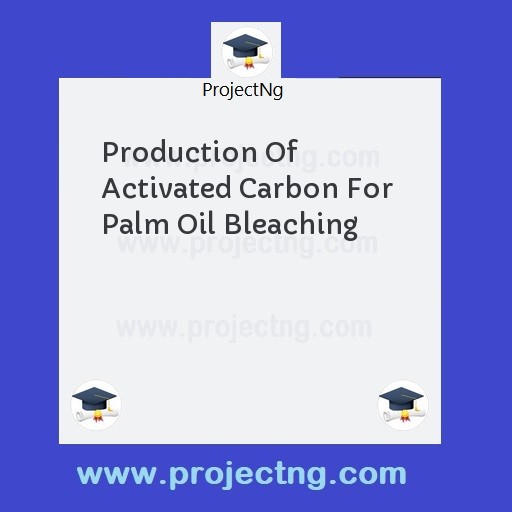Production Of Activated Carbon For Palm Oil Bleaching
Science Lab Technology Project Topics
Get the Complete Project Materials Now! »
PRODUCTION OF ACTIVATED CARBON FOR
PALM OIL BLEACHING
ABSTRACT
The production of activated carbon was carried out using the following: Charcoal, red oil, sulphuric acid, mortar, pestle, water, oven, conical flask, The methods or procedures undergone in the production of activated carbon are: charcoal selection, grinding, blending and activation. To activate carbon (charcoal), raw charcoal is grinded with mortar and pestle, then mixed thoroughly with acid and little water. The mixture was dried in an oven and allowed to cool before washing. The mixture was washed to reduce the level of acid, using ph chart to determine the acidic level. The mixture was continually washed with water until ph range of 3 – 4 was obtained in the ph chart. This was followed by oven drying and cooling to obtain the required activated carbon. It was observed that after the activation, the charcoal lost some percentage of its writing ability, Red oil which was expected to loose its coloration did not loose its color as expected.
Owing to this finding, we therefore conclude the use of activated carbon to bleach oil is not the best option to be adopted in bleaching of oil (palm oil).
CHAPTER ONE
1.0 INTRODUCTION
Activated carbon is a carbon that has been processed to have a large surface area available for adsorption or chemical reaction. It is also called activated charcoal, it has been observed from analysis that these activated carbon can be used in many things and ways which includes drinking water and waste water treatment, decolorizing liquids medical absorbent removal of priority organic pollutants, gas adsorption, sugar refining etc
In our institution, activated carbon technology are greatly in need to acquaint the students with sound knowledge of fluid flow phenomenon, adsorption and filtration by doing so it will go a long way in making our students to know much about bleaching of oil. Oil as we all know is what we encounter in everyday life, hence knowing their behavior and how to prepare them for better consumption will help in solving some problems encountered both in scientific and technological field.
In a bid to surmount this difficulty activated carbon was discovered. This activated carbon production however is among the practical operations designed to carry out some experiment in fluids. This technique is used in determining the purity of oil ability to be decolorized.
The measurement of these parameters was centered mainly on them totally. The procedure is all about absorption of the oil filtration by separation with respect to particle sizes, and the filtration was collected and discharged into beaker.
Whenever the velocity of the oil is charged either in direction of magnitude by a change in the direction or size of the conduct, friction generated in addition to the skin friction flow through the straight pipe connected. This friction loss includes loss from sudden expansion of the apparatus and the contraction of the apparatus leading to decreased flow of bleaching.
The properties and characteristic of the oil is important to the scientist because to process this operation, the foundation of the study is important. An understanding of the usage of activated carbons is very essential not only for accurate treatment of the problems of the oil in the experiment but also for the study of activating the carbon from its inact state. The branch of science that have to do with the activation of carbon, state the various sources oil carbon, these are: coconut shell, charcoal, ignite coal, petroleum pitch etc.
The carbon can be activated in two summarized parts: physical reactivation and chemical reactivation in our work, we use oil (palm oil) as the raw oil to be bleached which is regarded as crude palm oil.
Notably however, activated carbon is made up of the carbon as raw material, carbon dioxide, oxygen or steam in physical reactivation but in chemical activation prior to carbonization, the raw material is impregnated with certain chemicals like acid, strong base or salt, phosphoric acid, potassium hydroxide, sodium hydroxide, calcium chloride and zinc chloride.
The raw materials is carbonized at lower temperature (450 – 900oC) and it is believed that carbonization activation steps proceeds simultaneously with the chemical activation, the chemical activation is preferred to physical activation owing to the lower temperature and shorter time needed for activating material.
1.1 AIM AND OBJECTIVE
The aim and objective of this project work is:
To produce activated carbon that can be used in bleaching or decolourizing oil.
Be the First to Share On Social

Enjoying our content?
Don't miss out on new videos! Subscribe to our YouTube channel for more awesome content.
Subscribe Now!













